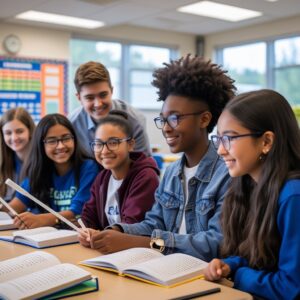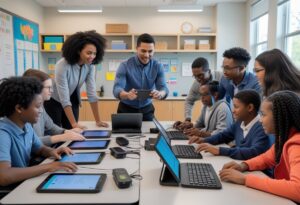Leveraging Technology for Deaf-Blind Independence

Empowering Lives Through Technology Innovation for Independence
As a leading assistive technology provider, we at New England Low Vision and Blindness understand the unique challenges faced by the deaf-blind community. Technology plays a pivotal role in fostering independence for individuals with dual sensory loss. From wearable devices like the Sunu Band that guide users through haptic feedback, to advanced communication tools such as Ray-Ban Meta Smart Glasses, innovations are continually expanding the possibilities for enhancing daily life.
Empowering individuals through technology is at the heart of our mission. As the digital landscape evolves, we are committed to exploring new ways to enhance autonomy and communication for those who are deaf-blind. Leveraging AI and other leading-edge advancements in mobility tools, we strive to create a world where independence and inclusion are accessible for all.
Discover NuCaption: Real-Time Solutions for the Deaf-Blind Community
 Empower communication with NuCaption, the innovative tool designed specifically for the Deaf-Blind community. This real-time captioning solution transforms the way individuals interact with the world, providing clear, accessible, and immediate text translation during conversations. Whether you’re at a meeting, in class, or enjoying social events, NuCaption bridges the gap and fosters inclusive environments.
Empower communication with NuCaption, the innovative tool designed specifically for the Deaf-Blind community. This real-time captioning solution transforms the way individuals interact with the world, providing clear, accessible, and immediate text translation during conversations. Whether you’re at a meeting, in class, or enjoying social events, NuCaption bridges the gap and fosters inclusive environments.
Learn more and explore how NuCaption can transform your experience today. Visit our product page NuCaption – Real-Time Solutions for the Deaf-Blind Community or watch our video.
Understanding Deaf-Blindness and Its Challenges
Deaf blindness presents unique challenges due to the dual sensory loss of hearing and vision. These challenges affect communication, social interactions, and the ability to navigate the world independently.
Definition and Prevalence
Deaf-blindness is defined by the significant combined loss of both hearing and vision, which limits access to the auditory and visual information normally relied upon for communication and orientation. This condition can be congenital or acquired later in life from causes like illness or injury. Deaf-blindness affects a small but significant portion of the population, varying greatly in severity from person to person. The dual sensory impairment requires specific strategies and technologies to support individuals.
Navigating Daily Life
Navigating daily life as a deaf-blind individual involves overcoming numerous hurdles, such as moving safely in public spaces and managing personal tasks independently. Assistive technologies play a crucial role in providing solutions that cater to individual needs. Devices like tactile sign language apps and braille displays allow for greater independence. These tools enable individuals to access information and communicate effectively, enhancing their ability to perform day-to-day activities. Our role at New England Low Vision and Blindness is to provide leading-edge solutions to empower individuals and improve their quality of life.
Social and Communication Barriers
Communication and social interaction can be significantly affected by deaf-blindness. Traditional methods, such as speaking or sign language, often rely on visual or auditory cues not available to those with dual impairments. Communication barriers can isolate individuals and limit interaction with others. To address this, specialized methods and tools, like tactile communication and technology that converts text to braille, can facilitate more effective social interactions. By breaking these barriers, we help create opportunities for more meaningful connections and participation in community life.
Technological Advances in Assistive Devices
We are dedicated to bringing hope and independence to those who are deaf-blind through advanced assistive technology. Innovations like hearing aids, braille displays, and screen readers expand access to communication and information in transformative ways.
Hearing Aids and Cochlear Implants
Hearing aids and cochlear implants are pivotal assistive technologies that enhance auditory capabilities for deaf-blind individuals. Hearing aids amplify sound, while cochlear implants provide direct stimulation to auditory nerves, making them essential for improving communication.
Hearing Aids
- Small, wearable devices
- Customize sound amplification
Cochlear Implants
- Suitable for severe hearing loss
- Involves surgical placement
Our goal at New England Low Vision and Blindness is to offer these leading-edge solutions that empower individuals to engage with the world around them.
Braille Displays and Notetakers
Braille displays and notetakers convert digital text into braille, offering tactile reading experiences that are vital for deaf-blind individuals.
Braille Displays
- Connect to computers and smartphones
- Provide instant text conversions
Notetakers
- Integrated with braille keyboards
- Enable quick note-taking
These devices not only facilitate independent learning but also enable professionals to work more effectively. We believe in providing the necessary tools that bridge the gap between technology and accessibility.
Screen Readers and Voiceover Services
Screen readers and voiceover services are crucial for navigating the digital space. These tools read aloud the text displayed on screens, making technology more accessible.
- Enable interaction with various applications
- Offer auditory feedback on different interfaces
Voiceover Services
- Available on most smart devices
- Assist in reading content without visual cues
Our commitment to enhancing accessibility ensures users can maintain independence and freedom in their digital interactions. As a leading provider of assistive technology, New England Low Vision and Blindness continues to support this journey with innovative tools.
Communication Technologies for Deaf-Blind Individuals
Our focus is on providing deaf-blind individuals with communication tools that promote independence. The integration of sign language, video relay capabilities, and AI-driven speech recognition opens doors for greater interaction and understanding in everyday life.
Sign Language and Interpreters
Sign language is a cornerstone of communication for those who are deaf-blind. With American Sign Language (ASL) at the forefront, tactile sign language apps are making it accessible even without visual input. When combined with interpreters, these technologies allow users to convert spoken language into tactile cues, offering a bridge to real-time conversation.
Innovations such as gloves that translate finger movements to digital text create a transformative experience. This approach enhances interaction within varied environments, fostering a sense of community engagement that traditional sign language alone may not fully achieve.
Video Relay and Captioning Tools
Video relay services are pivotal for enabling face-to-face communication across distances. These services help users connect to interpreters in a seamless manner, often using a smartphone or dedicated device. Alongside these tools, captioning technologies ensure spoken dialogue is visible to those relying on reading over hearing.
Captioning tools, like those that integrate directly within platforms such as Zoom and Google Meet, are crucial for accessibility. Through the use of clear and synchronous text, these tools make it easier for deaf-blind individuals to participate in virtual meetings and social interactions. This fosters a more inclusive environment where no member feels disconnected.
Speech Recognition and AI
Speech recognition paired with artificial intelligence is revolutionizing interaction. AI-driven technology identifies and transcribes speech into a readable format swiftly, significantly benefiting the deaf-blind community. By harnessing AI, individuals can have conversations translated into text, which is then conveyed through braille displays or tactile feedback.
These innovations broaden accessibility to everyday conversations, educational settings, and professional environments. Through refinement and adoption, these strategies help us break barriers, providing more inclusive communication options and empowering individuals to interact with the world at their own pace and comfort.
Nucaption Real-Time Solutions
Nucaption Real-Time Solutions for the Deaf-Blind Community revolutionizes communication with instant speech-to-text captioning. By converting spoken language into text delivered via tactile feedback and braille displays, it enables seamless interaction in educational, professional, and social settings. This innovative technology breaks barriers and empowers users to engage confidently with their world.
Mobility, Navigation, and Smart Environments
We aim to enhance the independence of the deaf-blind community with advanced technologies that address mobility and navigation challenges. GPS technology, smart home devices, and augmented reality significantly contribute to creating safer and more accessible environments.
GPS and Navigation Aids
GPS technology plays a crucial role in improving mobility for deaf-blind individuals. Tools like navigation apps on smartphones offer real-time guidance and location information. Features include spoken directions and tactile feedback, which help users traverse complex environments more independently.
Wearable devices also contribute to enhanced mobility. For instance, smartwatches with haptic feedback can guide users by gently vibrating to indicate directional changes. These technologies enable fluid navigation without relying on visual or auditory cues, fostering a greater sense of independence.
Smart Home Technologies
Smart home devices offer transformative solutions for creating accessible environments for those who are deaf-blind. Smart lighting systems can be programmed to change colors or flash as a notification method, indicating someone at the door or a timer ringing. Connected thermostats ensure comfort without the need for manual adjustments.
Interactive voice and touch-enabled interfaces assist in handling everyday tasks. For example, voice-controlled assistants can manage scheduling, while connected appliances offer tactile controls. These technologies simplify tasks, making homes more accessible and tailored to individual needs.
Augmented Reality and Environmental Cues
Augmented reality (AR) provides innovative ways to interact with the environment. Through AR-enabled devices, users receive real-time visual and auditory translation into tactile signals or text outputs, facilitating better comprehension of surroundings. This technology bridges the gap between physical spaces and the user’s interpretation.
Environmental cues enhanced by AR include vibrations or sound cues to navigate crowded spaces or busy intersections safely. Head-mounted displays can also offer real-time captions or descriptions, adding another layer of awareness. These advancements help users engage more fully with their surroundings, adding confidence to their movement and interactions.
Building an Inclusive Society for Deaf-Blind Individuals
Creating an inclusive society for deaf-blind individuals involves enhancing their access to education, career opportunities, and robust community support. We aim to foster an environment that embraces diversity and ensures full participation in daily life.
Educational Resources and Inclusivity
Inclusive education is crucial for empowering the deaf-blind community. Incorporating tactile and digital resources improves accessibility in classrooms. Touch and Teach methods are pioneering educational strategies that utilize tactile lesson plans and innovative digital tools.
These educational resources support effective communication, fostering an inclusive environment where all students feel valued. Collaborating with experts helps in developing tailored curriculums, promoting both academic and social growth. By integrating leading-edge technology, such as customized Braille displays and tactile sign language apps, we improve learning outcomes and enhance independence.
Career Opportunities and Workplace Adaptations
Ensuring career opportunities for deaf-blind individuals requires adaptive strategies in the workplace. Employers must understand how to effectively integrate assistive technologies that accommodate specific needs. This includes implementing tactile communication methods and modifying work environments to enhance accessibility.
Providing comprehensive training on the use of these technologies is essential. Job coaching and mentorship programs further support employment success, enabling individuals to excel in various fields. By promoting inclusive hiring practices and developing a supportive culture, workplaces can thrive with diverse talent.
Community Advocacy and Support Networks
Advocacy plays a vital role in building an inclusive society. Establishing support networks enables the deaf-blind community to connect and share resources. Engaging in community advocacy helps raise awareness of their unique challenges and promotes understanding.
Organizations like ours are dedicated to facilitating access to assistive technologies and creating inclusive platforms. We focus on building strong relationships with communities to ensure widespread implementation of supportive resources. By fostering collaboration among stakeholders, including educators, employers, and community leaders, we strengthen the societal framework to empower the deaf-blind community.
Frequently Asked Questions
We are committed to supporting the independence and empowerment of individuals with deaf-blindness through the use of leading-edge assistive technologies. This section addresses key queries regarding how these technologies can aid in communication, education, and daily independence.
What are some commonly used assistive technologies for students with deaf-blindness?
Students with deaf-blindness can benefit from assistive technologies like slant boards, picture boards, and specialized computer software. These tools improve communication and access to information, enabling students to participate fully in educational settings.
How can deaf-blind individuals utilize technology to communicate effectively?
Deaf-blind individuals can utilize tactile communication devices and tactile sign language apps to facilitate smoother communication. These tools translate digital signals into tactile feedback, bridging the communication gap.
What innovations in technology have recently been made to aid deaf-blind people in watching television?
Recent innovations include television systems designed to convert audio content into braille or text for deaf-blind individuals. These systems ensure greater engagement with media content by providing alternative ways to experience television.
What types of devices are currently available to support the independence of deaf-blind persons?
A variety of devices like specialized smart glasses and navigation aids support independence for individuals with deaf-blindness. These devices assist with communication, navigation, and everyday tasks.
Can you list some educational tools that cater to the specific needs of deaf-blind students?
Educational tools range from low-tech options such as tactile maps and braille books to high-tech solutions such as digital hearing aids and communicative devices. These tools are essential for enhancing the educational experience of deaf-blind students.
What is the latest assistive technology developed to assist individuals with deafness?
Recent developments in assistive technology for individuals with deafness include advanced hearing aids and cochlear implants. These technologies enhance auditory perception, providing users with greater access to sound and improving their quality of life.
Experience Empowerment with Our Deaf-Blind Training
Unlock independence and enhance accessibility with our specialized Deaf-Blind Training services. Whether you’re an individual seeking tailored solutions, an organization striving to create inclusive environments, or a caregiver aiming to support loved ones, our training is designed to provide practical tools and strategies.
👉 Learn More & Get Started Today
Discover NuCaption: Real-Time Solutions for the Deaf-Blind Community
 Empower communication with NuCaption, the innovative tool designed specifically for the Deaf-Blind community. This real-time captioning solution transforms the way individuals interact with the world, providing clear, accessible, and immediate text translation during conversations. Whether you’re at a meeting, in class, or enjoying social events, NuCaption bridges the gap and fosters inclusive environments.
Empower communication with NuCaption, the innovative tool designed specifically for the Deaf-Blind community. This real-time captioning solution transforms the way individuals interact with the world, providing clear, accessible, and immediate text translation during conversations. Whether you’re at a meeting, in class, or enjoying social events, NuCaption bridges the gap and fosters inclusive environments.
Learn more and explore how NuCaption can transform your experience today. Visit our product page NuCaption – Real-Time Solutions for the Deaf-Blind Community or watch our video.



